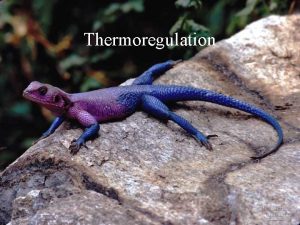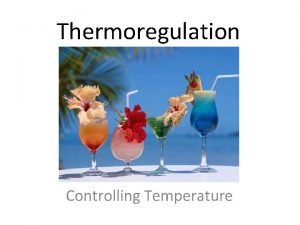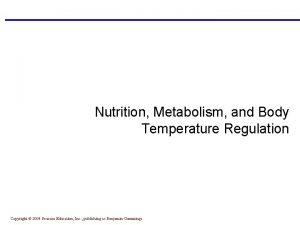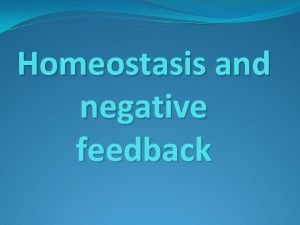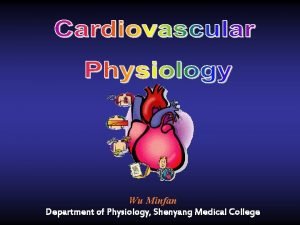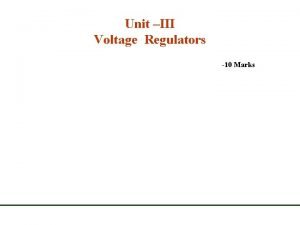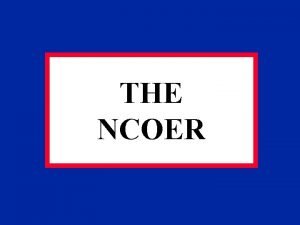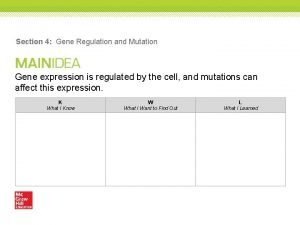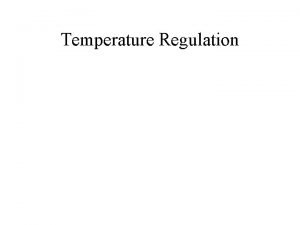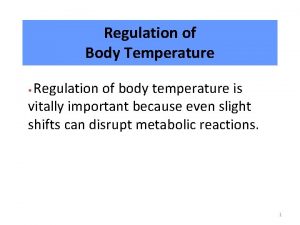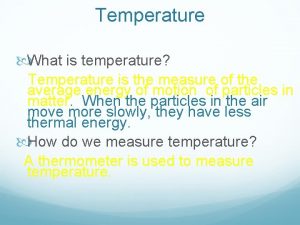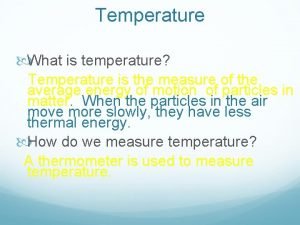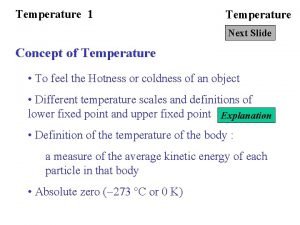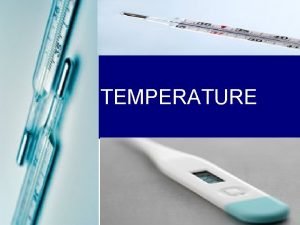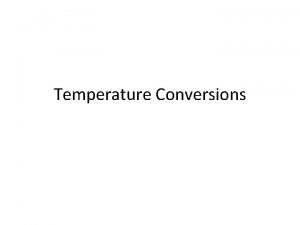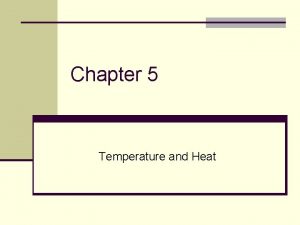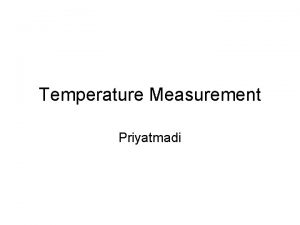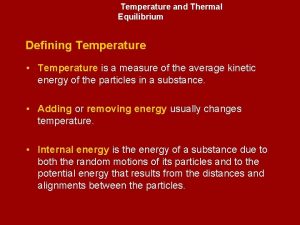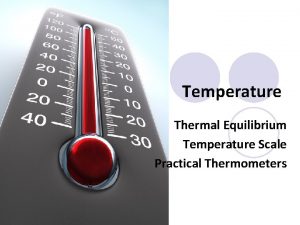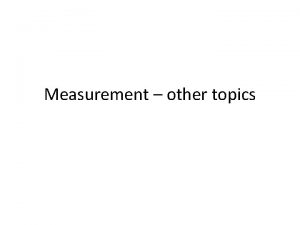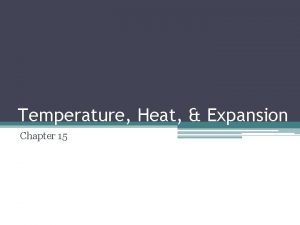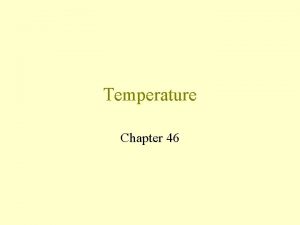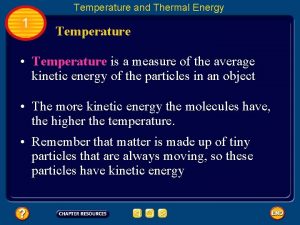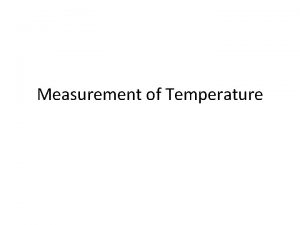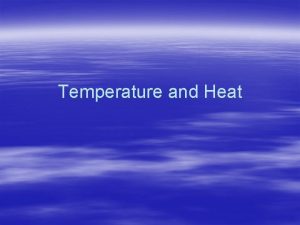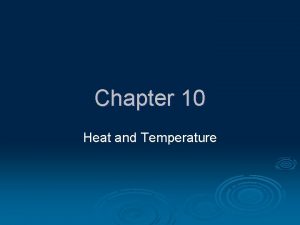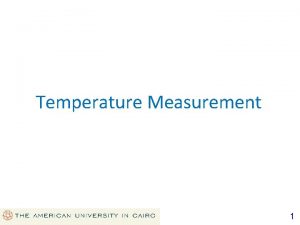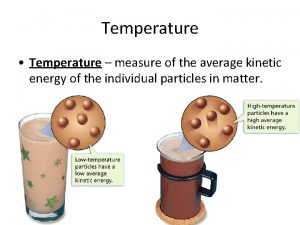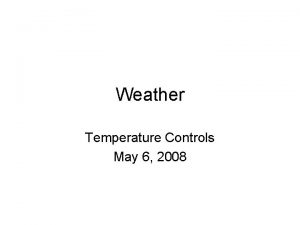Temperature Regulation Why temperature regulation Why temperature regulation


























- Slides: 26

Temperature Regulation

Why temperature regulation?

Why temperature regulation? • All organisms are limited by their ability to survive in different temperatures • Some, like reptiles and amphibia are poikilothermic • Others like humans are homeothermic

Core temperature The core temperature of the human body is 37°C ± 0. 6°C The core of the human body includes the organs of the thorax, abdomen and the head This is where the vital organs are located Their enzyme systems must operate in optimum conditions The periphery of the body can withstand some deviation from the core temperature

Core Temperature

Mechanisms of Heat Transfer 1) Radiation, especially infrared 2) Conduction: heat transfer by direct contact conductors – high conductance insulators – low conductance (high resistance) Convection: conduction due to movement of a liquid or gas

3) Evaporation 0. 58 Cal required to evaporate 1 g of H 2 O from the surface of the skin. heat of vaporization = 0. 54 Cal When environmental temperature > body temperature, evaporation is the only mechanism to cool the body.

Balance Body Skin Environment Basal metabolic rate Muscle activity Conduction Shivering Convection Vasomotor Radiation Sweating Evaporation Piloerection

So how is it regulated? Reference Set-point hypothesis Response Feedback Controlled system

Balance hypothesis Response cool warm Feedback Controlled system

Inputs Outputs Central thermosensors warm cool Peripheral thermosensors warm cool Anterior Hypothalamus Neural sweating shivering vasoconstriction vasodilation Hormonal adrenaline TRH

Central Control of Body Temperature Controlled Variable temperature of body core Set Point 37 o. C Receptors central thermoreceptors: in hypothalamus of brain peripheral thermoreceptors: in skin (mostly affect behavior, very little role in regulating core temperature) Control Center hypothalamus Effectors dermal blood vessels skeletal muscle endocrine glands brown fat sweat glands

Hypothalamic Control of Body Temperature When core body temperature drops below the set point, the following mechanisms are activated to increase body temperature: heat loss vasoconstriction [piloerection] heat production shivering muscle contraction generates heat hormone secretion e. g. , thyroxine, epinephrine (adrenaline) activation of brown fat e. g. , in human infants mitochondria generate heat instead of ATP

Hypothalamic Control of Body Temperature When core body temperature rises above the set point, the following mechanisms are activated to decrease body temperature: heat loss vasodilation (inhibit vasoconstriction) sweating heat production voluntary activity fuel intake thyroxine secretion

NEGATIVE FEEDBACK Thermoreceptors Core body temperature >37°C Thermoreceptors Hypothalamus Blood temperature Muscles of skin arteriole walls relax nerves Sweat glands increase secretion Muscles reduce activity Body loses heat Return to 37°C

NEGATIVE FEEDBACK Thermoreceptors nerves Core body temperature <37°C Thermoreceptors Blood temperature Muscles of skin arteriole walls constrict Sweat glands decrease secretion Hypothalamus nerves Muscles shivering Body loses less heat Body gains heat Return to 37°C

Babies • Babies have an extra mechanism (cant shiver) • Brown fat. • Suprascapular deposits • Rich in Iron containing mitochondria

And the menstrual cycle 37. 4 Postovulatory Rectal temp OC 36. 8 36. 2 12 Preovulatory 18 24 6 Time 12

Fever and hyperthermia An elevation of body temperature that exceeds the normal daily variation and occurs in conjunction with an increase in the hypothalamic set point---fever Fever due to a disturbance of thermal regulatory control----hyperthermia

Development of fever Pyrogenic activator Macrophage, monocyte, lymphocyte, etc. Endogenous pyrogen Thermoregulatory Centre Mediators in regulation of body temperature Rise in set point fever

Pyrogenic activator A substance that can manufacture and release endogeneous pyrogen which produces a fever. 1.Exogenous pyrogen bacteria virus other microorganism 2. internal metabolic product antigen-antibody complex steroid inflammatory substance

Fever • monocytes and phagocytes release endogenous pyrogen (Interleukin-1, IL-1). • The anterior hypothalamus is sensitive to IL-1 • Hypothalamic sensitivity to temperature is altered.

So… • The body temperature then becomes regulated at a new, higher level. • There is some evidence that the raised body temperature enables the fight against the infection.

But. . . • Every 1 OC rise in temperature increases basal metabolic rate and oxygen consumption by about 14%, • In acute infection, the ability to mobilise fat stores is inhibited.

Consequently • Skeletal muscle is broken down and the amino acids are used in gluconeogenesis. • This can be debilitating.

And even worse • In addition to the increased demand for energy • Temperatures (above 42 OC) damage nerve cells • impair thermoregulation • have more serious consequences.
 Why why why why
Why why why why Countercurrent exchange thermoregulation
Countercurrent exchange thermoregulation Negative feedback and body temperature regulation
Negative feedback and body temperature regulation Temperature regulation
Temperature regulation The term homeostasis literally means
The term homeostasis literally means Temperature regulation pdhpe
Temperature regulation pdhpe Dont ask why why why
Dont ask why why why Difference between curie temperature and neel temperature
Difference between curie temperature and neel temperature Difference between curie temperature and neel temperature
Difference between curie temperature and neel temperature Ferrimagnetism
Ferrimagnetism Why-why analysis
Why-why analysis Why do you cry willie
Why do you cry willie Does the table represent a function why or why not
Does the table represent a function why or why not What does the image represent
What does the image represent Why or why not
Why or why not Pengertian root cause analysis
Pengertian root cause analysis Homometric regulation of cardiac output
Homometric regulation of cardiac output Ddb board regulation #1 s. 2014
Ddb board regulation #1 s. 2014 Line regulation
Line regulation Navy hair regulations
Navy hair regulations Papillary duct of bellini
Papillary duct of bellini Zones of regulation stop opt go
Zones of regulation stop opt go Ncoer regulation ar 623-205
Ncoer regulation ar 623-205 Army bah regulation 608 99
Army bah regulation 608 99 Section 4 gene regulation and mutations
Section 4 gene regulation and mutations Bwf rules and regulations
Bwf rules and regulations Repressible operon
Repressible operon

